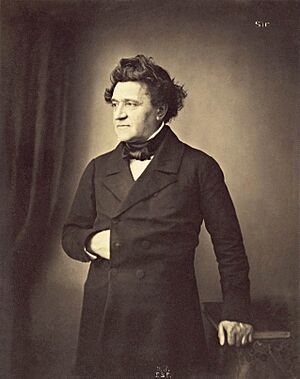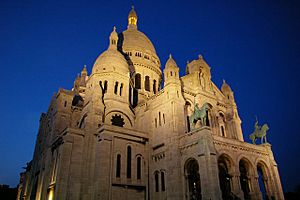Paul Abadie facts for kids
Paul Abadie (born November 9, 1812 – died August 3, 1884) was a famous French architect. He was also known for restoring many old buildings. He is seen as a key figure in a style called historicism, which means he often looked back at past architectural styles. His father, Paul Abadie Sr., was also an architect.
Abadie worked on restoring important buildings like Notre-Dame de Paris, the Église Sainte-Croix in Bordeaux, Saint-Pierre of Angoulême, and Saint-Front of Périgueux. In 1873, he won a competition to design the Basilica of the Sacré Cœur on Montmartre in Paris. He started its construction, but he passed away long before it was finished in 1914.
Contents
About Paul Abadie
Paul Abadie Jr. was born on November 9, 1812, in Paris, France. His father, Paul Abadie Sr., was also a well-known architect in France. Paul Jr. started studying at the School of Fine Arts (École des Beaux-Arts) in 1835. He studied under a teacher named Monsieur Achille Leclère.
Abadie worked with a group that looked after historical buildings. He helped bring back interest in medieval architecture. He traveled a lot to study old medieval places. Abadie was very interested in restoring medieval buildings and monuments. Some of his famous restoration projects included the Church of S. Front and the Cathedral of Angoulême. He also designed the City Hall (Hotel de Ville) in Angoulême.
In 1845, he became the second inspector for the restoration of Notre Dame de Paris. He worked under famous architects like Viollet-le-Duc and Lassus. In 1862, he was chosen as the architect for church buildings in the area of the Saint André Cathedral of Bordeaux. He had already restored the front of the Saint-Croix church there between 1859 and 1865.
In 1871, he became a member of the group that looked after historical monuments. In 1872, he became the general inspector of church buildings. Then, in 1874, he became the church architect for Paris, taking over from Eugène Viollet-le-Duc.
In 1873, he entered a competition to design a new basilica on Montmartre, a hill overlooking Paris. His design was chosen over 12 others by Cardinal Joseph Guibert. This design became the basis for the Sacré-Cœur, Paris. Abadie started building it in 1875, but he did not live to see it finished. In 1874, he also replaced Viollet-le-Duc as the architect for Notre Dame of Paris. In 1875, he was elected to join the Académie des Beaux Arts, a famous art academy.
Besides his work for churches and the government, Abadie took on only one private project. This was Mailleberchie Castle in 1875. He designed it in great detail as a complete neo-medieval artwork. This included stone carvings, gargoyles, stained glass windows, metalwork, wood carvings, and even furniture.
Abadie began the Basilica of Sacré Cœur, but he passed away during its construction. He died on August 3, 1884, in Chatou, France.
Buildings and Restorations
Buildings He Designed
- Basilica Sacré-Cœur, Paris, France
- Church of Chatou, France
- Neo-Romanic Church of Saint-Georges of Mussidan, France
- Mailleberchie Castle, Villebois-Lavalette, France
Buildings He Restored
- Notre Dame de Paris (he worked under Viollet-le-Duc at first)
- Church Sainte-Croix Bordeaux Church
- Saint-Michel Tower, Bordeaux, France
- Saint-Ferdinand Church, Bordeaux, France
- Church of the Bastide (Église de la Bastide), Bordeaux, France
- Sacristy of the Saint-André Cathedral, Bordeaux, France
- Great Synagogue of Bordeaux, Bordeaux, France
- Saint Front Périgueux Cathedral, Périgueux, France
- Saint-Georges Church, Périgueux, France
- Saint-Pierre Abbey of Brantôme, France
- Angoulême Cathedral, Angoulême, France
- Saint-Étienne Cathedral, Cahors, France
- Saint-Léger Church, Cognac, France
- Château d'Angoulême, Angoulême, France
- Saint-Martial Church, Angoulême, France
- Sacré-Cœur, Paris, France
Other Works
- Grave monument for Jean-Louis Guez de Balzac, Hôtel Dieu (Chapel), Angoulême, France
His Impact and Legacy
For a while, some experts in the mid-1900s did not appreciate Paul Abadie's work. They thought he was too imaginative and that he damaged some older Romanesque buildings. They also felt he added his own made-up sculptures to old buildings. For example, at the church of St Michel d'Entraygues, he added a strange carving of a three-headed "Green Man." Even though the church looks interesting, it had no real connection to the Templars. Abadie's restoration work at Périgueux Cathedral and Angoulême Cathedral was also criticized. People said his changes were more based on guesses than on true history.
However, since the 1980s, people have started to see his work in a more positive way. They now recognize his important role in the "neo-medieval" movement. They also see his unique style compared to his famous contemporary, Viollet-le-Duc. Many towns in the Charente and Dordogne areas of France are thankful to him. He restored many church buildings that were in very bad shape or had been ignored for centuries. This includes places like Angoulême, Périgueux, and Cahors, where he was the church architect from 1849 onwards.
His buildings, especially Sacré Cœur, inspired many other churches and pilgrimage sites. Examples include the Basilica of the Sacred Heart, Brussels, built from 1919 to 1960, and the basilica Sainte-Thérèse de Lisieux, built from 1928 to 1954. He also inspired many other churches, especially in Paris. These include Saint-Esprit, Saint-Pierre-de-Chaillot, and Sainte-Odile.
See also
 In Spanish: Paul Abadie para niños
In Spanish: Paul Abadie para niños



